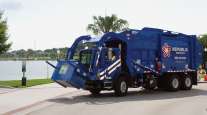EPA Expands SmartWay to Drayage Trucking With Initiative to Reduce Emissions at Ports
This story appears in the July 4 print edition of Transport Topics. Click here to subscribe today.
The Environmental Protection Agency has expanded its SmartWay Transport Partnership with a new initiative — one that aims to reduce emissions in drayage trucking.
“EPA’s SmartWay dray truck initiative will help ports contribute to their local economies — while protecting the air quality, environment and public health of nearby communities,” Gina McCarthy, assistant administrator for EPA’s Office of Air and Radiation, said in a statement announcing the program June 28. OAR oversees SmartWay through its Office of Transportation and Air Quality.
The agency’s goal is to spur drayage fleets to replace their oldest trucks, since newer trucks produce fewer harmful emissions, it said.
Guidelines for the voluntary program differ from those for the main SmartWay program designed for highway operations.
“Everybody recognizes that we need cleaner air,” said Gerard Coyle, vice president of environmental and sustainable operations at Evans Delivery Co., which runs about 1,700 drayage trucks. Coyle helped EPA tailor the program for drayage and his company is one of the charter participants in the initiative.
“We recognize that we need to look at these older trucks and we need to start to figure out ways to get them out of the fleet and get them into the scrap pile,” he told Transport Topics.
EPA launched the new program at a press conference at the Port of Charleston, S.C. Joining EPA were representatives from the Environmental Defense Fund and the Coalition for Responsible Transportation, a group of shippers, carriers and other stakeholders targeting improved environmental conditions at ports.
SmartWay’s initiative asks drayage truckers to track their fleet’s emissions of fine particles less than 2.5 millimeters, also known as PM 2.5 emissions, and to reduce those emissions to 50% less than the industry average over a three-year period, EPA said.
Participants are also asked to track nitrogen oxide emissions and reduce them to 25% below the industry average over the same three-year period.
Last, the initiative asks shipper participants to hire SmartWay fleets to carry 75% of their freight.
“I think it’s a good government-private partnership way to move forward,” said Curtis Whalen, executive director of American Trucking Associations’ Intermodal Motor Carriers Conference.
“It uses market incentives and the other things that have been part of the [SmartWay] program successfully for a long time,” he added.
Whalen praised the program’s focus on shippers, asking them to use SmartWay fleets.
“You start there and they commit to doing these things, they commit then to having and retaining the services of companies that share the goal and are reducing the emissions in their equipment and using newer equipment,” he said.
Focusing on the shipper also will make shippers more willing to pay the extra costs associated with newer trucks and emissions-reduction technology, Whalen added. “The commitment you will hear from them is they understand that obligation,” he said.
Unlike the main SmartWay program, which includes fuel efficiency in its goals for carriers, the drayage initiative focuses only on emissions.
Drayage presents difficulties to improving fuel efficiency, such as long lines, short hauls and heavy loads, Whalen said. And while the SmartWay program designed for highway fleets focuses on improvements such as aerodynamic trailers to improve efficiency, that would be extremely hard in drayage.
“You can’t really do that in the intermodal environment,” Whalen said. “A lot of times they’re short hauls, the chassis are banged around a lot, boxes are coming on and off.”
Nonetheless, newer trucks are usually more fuel-efficient than older ones, so the initiative probably will increase efficiency.
Drayage trucks usually are older than trucks used for other hauls, Coyle said, because the economics favor the old models.
“The average drayage truck gets about 65,000 miles a year, which would be half of a road truck,” Coyle said. “They don’t need a brand-new truck to do it, and the economics of the dray-age business wouldn’t support a very expensive truck.”
Drayage is a highly competitive market, so the business wouldn’t support an expensive truck, he said.
Carriers such as Evans — with a highway fleet as well as a drayage fleet — can participate in both SmartWay programs with those separate fleets, Coyle said.




